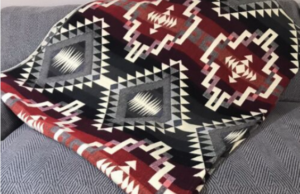Wool blankets are made from the fleece of sheep or other wool-producing animals such as alpacas, llamas, or goats. The process of making a wool blanket typically involves the following steps:
Shearing: The wool is harvested from the animal by shearing off the fleece.
Sorting: The fleece is sorted by color, texture, and quality. The best quality wool is used for blankets.
Cleaning: The wool is scoured to remove dirt, grease, and other impurities from the fleece.
Carding: The cleaned wool is carded, which involves separating the fibers and aligning them in preparation for spinning.
Spinning: The wool is spun into yarn using a spinning wheel or other spinning equipment.
Weaving: The yarn is then woven into a blanket on a loom. The weaving process involves interlacing the yarns to create a strong, durable fabric.

Finishing: The finished blanket is then washed, dried, and brushed to soften it and give it a fluffy texture.
Some wool blankets may also be dyed or printed with designs or patterns, depending on the desired look and style. The process of making a wool blanket can vary depending on the quality and type of wool used, as well as the manufacturer’s specific production methods.
Types of wool used in blankets
Wool is a natural fiber that is derived from the fleece of various animals, including sheep, alpacas, llamas, and goats. Wool is known for its warmth, softness, and durability, which makes it an ideal material for blankets. Here are the different types of wool that are commonly used in blankets.
Merino Wool
Merino wool is one of the most popular types of wool used in blankets. It is derived from Merino sheep, which are known for their fine, soft fleece. Merino wool is highly prized for its softness, warmth, and moisture-wicking properties. It is also naturally hypoallergenic, which makes it a great choice for people with allergies or sensitive skin.

Cashmere Wool
Cashmere wool is a luxurious and highly prized material that is derived from the fleece of cashmere goats. It is known for its softness, warmth, and lightweight feel. Cashmere wool is also highly durable and has a natural sheen that gives it a luxurious look and feel. Cashmere wool blankets are usually more expensive than other types of wool blankets due to the high cost of the raw material.
Alpaca Wool
Alpaca wool is another popular type of wool used in blankets. Alpaca wool is derived from the fleece of alpacas, which are native to South America. Alpaca wool is known for its softness, warmth, and hypoallergenic properties. It is also highly durable and resists pilling and shedding, which makes it a great choice for high-quality blankets.
Mohair Wool
Mohair wool is derived from the fleece of Angora goats. It is known for its softness, warmth, and natural sheen. Mohair wool is highly durable and resistant to pilling, which makes it a great choice for blankets. However, it is not as warm as other types of wool, so it may be better suited for lighter-weight blankets.
Lambswool
Lambswool is derived from the first shearing of lambs when they are around six months old. It is known for its softness, warmth, and durability. Lambswool is also highly elastic, which makes it great for blankets that need to be able to stretch and move without losing their shape.
In addition to these types of wool, there are also blends of different types of wool that are used in blankets. For example, wool and cotton blends are often used to create blankets that are lightweight, soft, and easy to care for. Wool and silk blends are also popular for creating luxurious blankets with a soft, silky feel. The type of wool used in a blanket will depend on the desired properties of the finished product, as well as the manufacturer’s specific production methods.